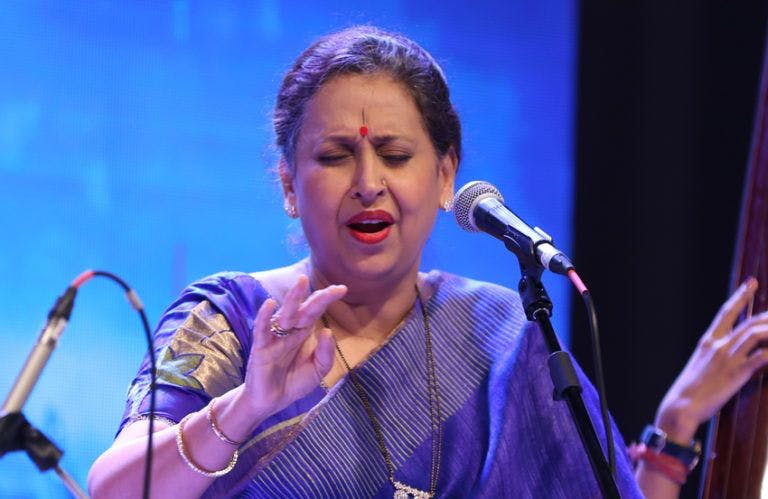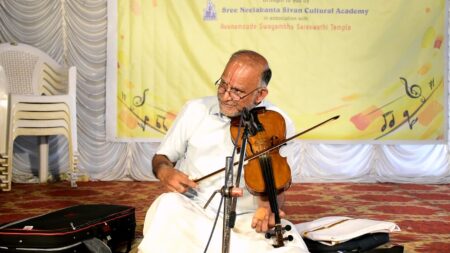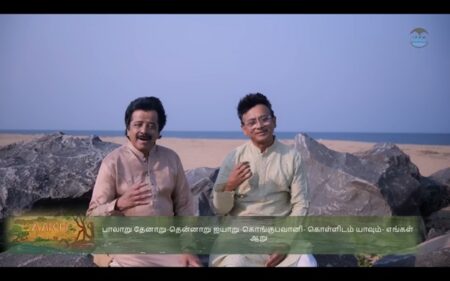With foundations in multiple Gharanas and genres of music, Arati Ankalikar Tikekar is proof that music flourishes in the social and cultural milieu.
Arati Ankalikar Tikekar is among a very few Hindustani classical singers who can sing bhajans or devotional songs, bhava geetes (or emotion-based songs) like Mi Radhika, and even songs like Ugavali Shukrachi Chandani from Marathi folk genre Lavani with equal flair. Her classical singing foundation is an effective blend of three distinct genres or gharanas belonging to Gwalior, Agra and Jaipur. Her deep voice, command on sargams, various laya patterns, and tans, and presentation of compositions in various talas, mesmerise her audience.
Rigorous talim
Tikekar received talim or training under various Gurus, but her first teachers were her parents. Even though they were not trained professional artists, they were emotive singers. There was a spiritual atmosphere at her home, where devotional songs (bhajans) were sung throughout the day.

A Haripath is a collection of 28 Abhangs or peoms written by Marathi saint Dnyaneshwar. Tikekar was well versed with 12 Abhangs as a child. “I grew in the atmosphere of music, and spirituality. When I came back from school, I would sing all the songs I knew non-stop, for 1.5 hours,” says Tikekar reminiscing her childhood. “This is how my parents noticed my talent in music and decided to take it further,” she adds.
Vijaya Joglekar, was Tikekar’s first guru – a close neighbour, who formally started teaching Tikekar when she was six. “My parents would accompany me to the class, and later at home I had to repeat everything I learned. Only then, my father would allow me to have dinner,” says Tikekar.
She also recalls how her father would take her to concerts in the vicinity and would bribe her with Vada Paav in the interval. “In the beginning, I would go to concerts for Vada Paav, but later, as I went on listening, music started touching my soul,” she says.
Rules of ragas
When we learn music, we learn the rules of the ragas. “This facilitates our basic understanding. However, listening to great masters makes us see the soul of the raga,” says the singer.
During the course of learning music and attending competitions, Tikekar was also inspired by one of her friends Sadhana Sargam — who went on to become popular as a playback singer in the film industry.
“I would often take part in various music competitions, and Sadhana would be always there. She is a year younger to me. When I was around 7, I heard Sadhana render a beautiful Khayal with Alaps and Tans, I was highly inspired. I thought that I also should be able to sing like her. In a way, she is also my Guru.
Tikekar shares how Joglekar would insist on practicing a song at least 400-500 times. “She used to say that if you sing a particular song 5-10 times, you will understand it. If you sing 20 times, you will be able to render smoothly. If you sing it 100 times, it would sound beautiful, but when you sing it 500 times, it will develop its own aura,” recalls Tikekar.
Tikekar’s father who supported this theory devised an interesting way to keep track of his daughter’s practice sessions. During each session, her father would take a pot full of beads and would pick one bead out of the pot and keep it aside every time she repeated the song.
“In the same way, he made me master various Tans, which helped me immensely. When a musician’s body, intellect, and imagination are in tune, she can express whatever comes to her mind. For this, basic physical preparation including mastery over one’s voice, and musical powers is the foremost requirement, and my father, through his strict disciplinary actions, made me do it, without any shortcuts,” explains Tikekar.
Experiences under various Gurus
After Joglekar, Tikekar learned under various Gurus such as Vasantrao Kulkarni, Kishori Amonkar, Ulhas Kashalkar, and finally Dinkar Kaikini. Tikekar says that Kulkarni had excellent knowledge of Gwalior and Agra Gharana. “He would tell us that the beauty of the raga is not just in its notes, but the way in which you connect them through Meand, Kan, Gamaks, etc.” The Wadi and Samwadi and the other Raga rules are meant to establish the Raga atmosphere, but the duty of the artist is to go beyond these and make the raga rendition unique.
Tikekar learned under Amonkar for just two years, but it was a “unique experience”. She adds, “As I was listening to more concerts, I got attracted to Akara based singing, and so I was introduced to Kishoriji. When she would take up a Raga, it would sound like she, and all of us are floating in its bubble. I wondered, everyone teaches the same raga, the same compositions, but what is it in Kishoriji’s music, which transcends the barriers of individuality and makes me the Raga itself.”
This was also one of the milestones as she began her journey into a deeper understanding of music or in her words “my perseverance towards reaching the abstract”. Tikekar says that she realized that a composition is a window to see into the huge space called raga, but a raga is also a window, which helps you see the divinity within everyone. “When we sing a Raga, we are not singing mere notes of the raga, but try to build the raga’s atmosphere according to our musical capacity, and personality.”
Emotions behind the music
Apart from classical music, Tikekar also found success in light music through films and private albums. She says it was a learning experience when she took up these projects. “When we sing classical music, our focus is only on the raga bhava, which is a an effective amalgamation of swara bhava, laya bhava, and shabda bhava. Each rhythmic cycle in a raga rendition is like a floor in a huge building. However, when we sing light music, our focus is entirely on portraying the words and emotions behind them,” explains Tikekar. Therefore, an artist should not think about the raga of the song, but about the emotions of words, and how they should be expressed, she says.
Considering she has experience in both classical as well as light music, Tikekar has better clarity on how to deliver the songs for different mediums. “For example, I sang the song ‘Ghar Naahi Hamre Shyam’ for the film Sardari Begum. The song is based on Raga Nand. if I focus on the raga, I won’t be able to go beyond it. However, if I focus on words, and emotions of parting and longing in the song, I can express the same using some other notes, which are not in that raga.”
Music, a way of life
For every artist, the discipline they follow, the perfection they seek to conquer becomes the central focus. “Indian classical music makes you discover your inner self. For every artist, music is a reflection of her soul, and her life experiences, her joys, and her sorrows,” says Tikekar.
As she attended the concerts, practiced music, learnt from different gurus, Tikekar says she realized the kind of music she enjoys. “I realized that, I want to fly like a bird, without any restrictions, and Raga-based music is the key.”
With practice and a lifetime of dedication to music, Tikekar has come to achieve a deep understanding of self and her music. “Earlier my music reflected my personality. But as I kept on practicing, music showed me how to react to different situations in life,” she says.
“For example, when you elaborate a raga in an extremely slow tempo, singing taans would not sound good. Just like that, different things sound good at different times. As I grew older, I started realizing the importance of correct pauses, and how silence also can speak louder than singing. I understand that I need not react to each and everything in life.” Tikekar, who is now in her 50s, further explains.
Talking about how emotions reflects in the music, Tikekar says, “If your heart breaks for some reason, it would be reflected in your music. I learn something from each of my student. Before I teach anyone, I find out about her personality, her life history, her family background, her musical capacity among other things, and then teach the student based on the information.”
Tikekar has traversed through this journey in music and has understood every nuance of music with the help of her parents and her gurus. She doesn’t hesitate to acknowledge how her gurus have helped her become what she is today.
Write to us at [email protected]



